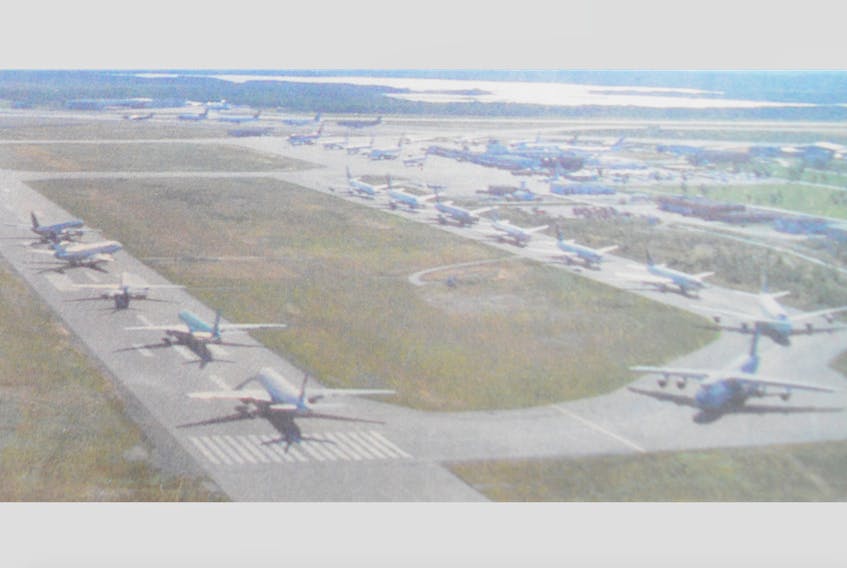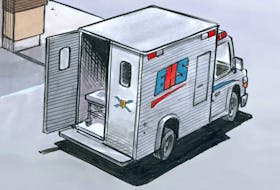Newfoundland and Labrador has been part of aviation history on several occasions.
Its important place in the story of flight was cemented in June, 1919, when aviators, John “Jack” Alcock, and Arthur Whitten Brown made the first non-stop trans-Atlantic flight from St. John’s to Ireland in a modified Vickers Vimy bomber.
In 1932, aviation history was made once more when famed pilot Amelia Earhart lifted off from Harbour Grace in her Lockheed Vega. Touching down at Londonderry, Northern Ireland, about 15 hours later. She became the first woman to cross the Atlantic solo.
In the 1940s another glorious chapter was added to Newfoundland’s place in the story of flight, as the Newfoundland Airport, Gander (opened, 1938) became a vital cog in the Allied war effort. Sixty years later, now officially named the Gander International Airport, the facility took centre stage in world news for hosting some 38 aircraft and their passengers, stranded during the terror attacks on Sept. 11, 2001.
This simple note points us toward an adventure rivalling anything in Earhart’s career, or even that of Charles “Lucky” Lindberg.
These stories, and many more, are proudly remembered by Newfoundlanders, who cherish our connection with the skies. Still, there is one piece of provincial aviation history that few of us know about, and which was only associated with our neck of the woods by accident.
On Monday, Sept. 13, 1936, Police Constable John Harvey, stationed on Fogo Island, made a short entry in his official journal.
It read: “[An American] aeroplane crashed at Musgrave Harbour.”
This simple note points us toward an adventure rivalling anything in Earhart’s career, or even that of Charles “Lucky” Lindberg.
The adventure had its beginnings with Henry T. “Dick” Merrill, a pilot with Eastern Airlines. As we’ve seen, by 1936 the Atlantic run had already been conquered, so Merrill decided on a more ambitious flight – a round-trip voyage from New York to London. There was one catch; the costly project was beyond Merrill’s means. To make it happen he teamed up with Harry Richman. A celebrity vocalist and part-time pilot, the well-heeled Richman had both the interest and resources to make an ideal partner for Merrill.
The aircraft the duo selected for their attempt was a Vultee V-1A. This single-engine, metal aircraft was chosen for its speed and durability. Christened Lady Peace, the plane was modified to carry extra fuel, while hollow areas of its wings and fuselage were packed with 40,000 ping pong balls, so Lady Peace would float if Merrill and Richman were forced to crash land on the water. To this day the venture is remembered as, “The Ping Pong Flight.”
For most of the first leg all went well, until the aviators ran into a large thunderstorm about 1,000 kilometres off the English coast.
Lady Peace departed New York for London on Sept. 2 flying the “great circle” route towards Europe. For most of the first leg all went well, until the aviators ran into a large thunderstorm about 1,000 kilometres off the English coast. Pounded by high winds, and running low on fuel, they decided to put down short of London, in a farmer’s field in Wales. Merrill and Richman set a speed record for an Atlantic crossing, arriving at their intended destination the following day.
A few days later Lady Peace was airborne once more, making its way back to North America.
Once again, things didn’t go quite as the aviators had planned, and this unexpected hitch forever linked a small town in central Newfoundland with the Ping Pong Flight.
Encountering strong headwinds and noticing that the Vultee’s wings had begun to ice up, Merrill took the plane to a lower altitude to clear them. Unfortunately, Richman mistook this for a splashdown in the ocean, and rashly dumped some 1,900 litres of fuel. Realizing they now hadn’t enough petrol to make New York, Merrill was forced to make a real emergency landing.
Their accidental landing place was on a soft bog near the community of Musgrave Harbour. Named for one-time Newfoundland Governor, Anthony Musgrave, it was and is, a fishing town of about 1,000 people.
At this point the famous Newfoundland hospitality came to Merrill and Richman’s rescue, as locals aided them in extracting the aircraft from the bog.
While the marshy surface of the bog saved Lady Peace from serious structural damage, it did suffer a bent propellor during the landing. At this point the famous Newfoundland hospitality came to Merrill and Richman’s rescue, as locals aided them in extracting the aircraft from the bog. With this assist, the pair were soon able to fix the propellor and carry out other minor repairs. After refuelling, they took to the skies once more on the final leg of their journey.
A few days later Merrill and Richman arrived triumphantly in New York, their flight a roaring success.
Though the strains of the journey, especially Richman’s fuel dump, had tested their friendship, it’s reported that the now-famous aviators remained on good terms. Merrill went on to make three more trans-Atlantic flights, flew as a civilian transport pilot in the Second World War in China, and retired from Eastern Airlines in 1961.
Acting in several Hollywood movies, Richman’s popular singing career continued on into the 1940s, when he left show business.
Musgrave Harbour has moved on as well. Tourism now provides an important part of its economy, with visitors lured by its hiking trails and famous sandy beach. Even so, for anyone who cares to remember, this outport on Newfoundland’s Kittiwake Coast will always be linked to a pioneering feat of Atlantic aviation.
David J. Clarke is a graduate of Memorial University's Doctoral program in history, and he is the author of eight books focusing on central Newfoundland. He can be reached at [email protected].









